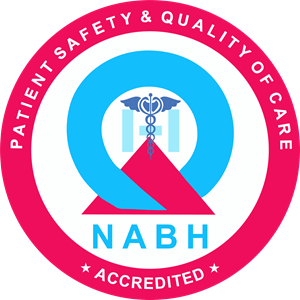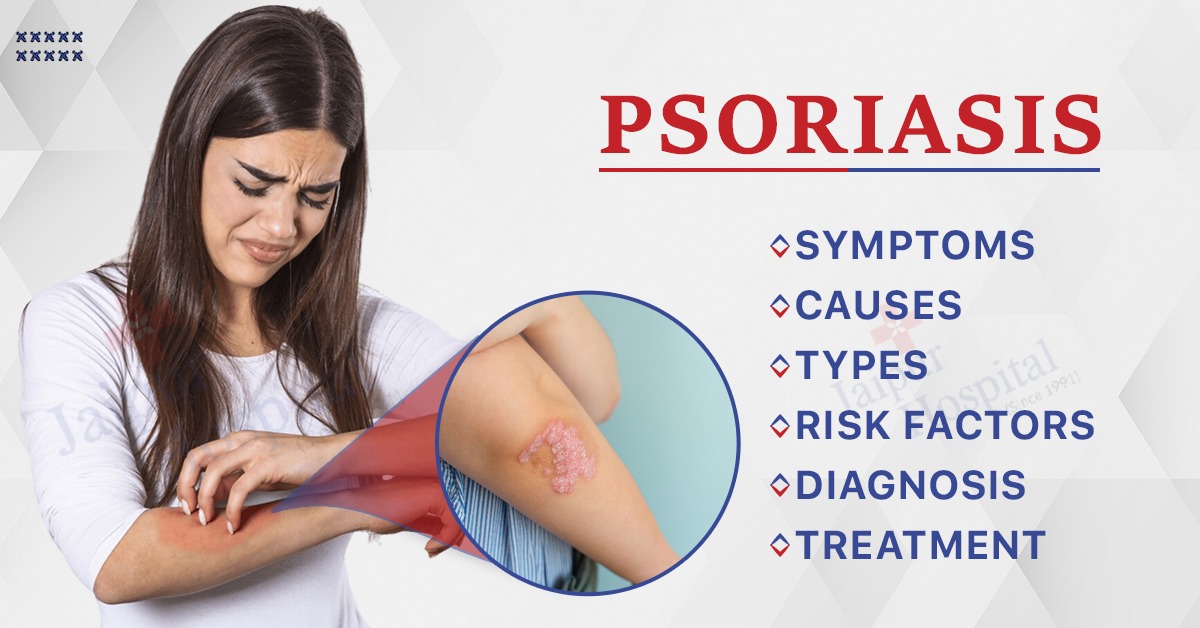What is Psoriasis?
Skin cells quickly accumulate as a result of the chronic autoimmune skin disease psoriasis. Usually, skin cells are produced and shed over about a month, but in psoriasis, this process is accelerated to a matter of days. This results in the accumulation of thick, red patches of skin covered with silvery scales, which can be itchy, painful, and may even crack and bleed.
It is thought that a mix of genetic and environmental factors contribute to psoriasis. It is not contagious, as it is an autoimmune disorder that involves the immune system mistakenly attacking healthy skin cells. The exact cause of this immune response is still not fully understood, but it is thought to involve a complex interplay between immune cells, genetics, and triggers like stress, infections, certain medications, and even weather changes.
Symptoms of Psoriasis
Psoriasis symptoms can vary widely depending on the type of psoriasis and its severity. Here are the common symptoms associated with different types of psoriasis:
Plaque Psoriasis (Psoriasis Vulgaris):
- thick, silvery scales covering raised, rosy skin areas.
- Skin that is dry and cracked and may bleed or itch.
- Discomfort or pain in affected areas.
- Patches often occur on the elbows, knees, scalp, lower back, and buttocks, but they can appear anywhere on the body.
Guttate Psoriasis:
- Small, red, teardrop-shaped spots.
- Patches are usually widespread and may appear suddenly.
- A bacterial infection, such as a streptococcal throat infection, is frequently the cause.
Inverse Psoriasis: - Smooth, red, inflamed patches that tend to occur in skin folds (armpits, groin, under breasts).
- These areas may become irritated and cause discomfort due to friction and sweating.
Pustular Psoriasis:
- Pus-filled blisters surrounded by red skin.
- Blisters may appear on hands, feet, or other areas.
- This type can be painful and may cause fever and chills.
Erythrodermic Psoriasis:
- Widespread redness covering large areas of the body.
- Skin shedding in large sheets.
- Severe itching and pain.
- This type is rare but can be life-threatening if not treated promptly.
Additionally, people with psoriasis may experience emotional and psychological impacts due to the visibility of the condition and the potential discomfort it causes. Many individuals report feelings of self-consciousness, embarrassment, and lowered self-esteem.
It’s important to note that psoriasis is a chronic condition with periods of flare-ups and remission. Flare-ups can be triggered by various factors, including stress, infections, certain medications, cold weather, and skin injuries.
Causes of Psoriasis
The exact cause of psoriasis is not fully understood, but it is believed to result from a combination of genetic, immune system, and environmental factors. Here’s a breakdown of the main factors thought to contribute to the development of psoriasis:
Genetics: A big factor in psoriasis is family history. Many psoriasis sufferers have one or more affected family members. An elevated risk of psoriasis development is linked to specific genetic variants. Although it increases vulnerability, having these genetic markers does not ensure that a person will experience psoriasis.
Immune System Dysfunction: Psoriasis is considered an autoimmune disorder. In a healthy immune system, immune cells help defend the body against infections and harmful substances. In psoriasis, immune cells mistakenly target and attack healthy skin cells, triggering an inflammatory response. This leads to the rapid production of new skin cells, causing the characteristic buildup of scales and patches.
Environmental Triggers: Various environmental factors can trigger or exacerbate psoriasis symptoms in individuals who are genetically predisposed. Common triggers include:
-
- Infections: Bacterial or viral infections, particularly streptococcal infections, can lead to the onset or worsening of psoriasis symptoms, especially in the guttate type.
Stress: Emotional stress can trigger flare-ups or exacerbate already-present symptoms.
-
- Injury to Skin: Trauma to the skin, such as cuts, burns, or insect bites, can trigger psoriasis at the site of injury, a phenomenon known as the Koebner response.
- Medications: Certain medications, such as beta-blockers, lithium, and antimalarial drugs, have been linked to triggering or aggravating psoriasis symptoms.
Climate: Cold, dry weather or excessive sun exposure can influence psoriasis symptoms.
-
- Hormonal Changes: Changes in hormonal levels, such as during puberty, pregnancy, and menopause, can impact psoriasis symptoms.
- Lifestyle Factors: Lifestyle choices can affect psoriasis as well. Smoking, excessive alcohol consumption, and obesity have been associated with an increased risk of developing or worsening psoriasis.
It’s important to note that while these factors are believed to contribute to psoriasis, the condition is complex and can manifest differently in different individuals. Moreover, the interplay between genetics, immune responses, and environmental triggers is not fully understood. If you suspect you have psoriasis or are experiencing symptoms, it’s recommended to consult a healthcare professional for proper diagnosis and personalized treatment recommendations.
Also Read: What are Hormones? Types, Functions, and Diseases
Types of Psoriasis
There are numerous varieties of psoriasis, each with distinctive signs and symptoms. The most typical forms of psoriasis consist of:
Plaque Psoriasis (Psoriasis Vulgaris):
- The most typical form of psoriasis is this one.
- Raised, crimson skin patches with silvery-white scales are its defining feature.
- These plaques or patches may itch and be uncomfortable or painful.
- commonly found on the scalp, lower back, buttocks, elbows, and knees.
Guttate Psoriasis:
- It frequently happens when a youngster or young adult.
- characterized by skin patches that are tiny, red, and resemble drops.
- prone to being brought on by streptococcal infections, such as strep throat.
Inverse Psoriasis (Flexural Psoriasis):
- Affects skin in areas where there are skin folds, such as the armpits, groin, under breasts, and buttocks.
- Presents as smooth, red, inflamed patches of skin that may be tender or painful.
Pustular Psoriasis:
- itself as red skin with white pustules around it.
- Can be localized to certain areas (such as palms and soles) or more widespread.
- May cause fever, chills, and a feeling of being unwell.
Erythrodermic Psoriasis:
- Huge parts of the body are covered by an uncommon and severe form of psoriasis.
- Skin appears intensely red, and inflamed, and often sheds in sheets.
- Can be accompanied by severe itching, pain, and increased heart rate.
Psoriatic Arthritis:
- Not just a skin condition, psoriatic arthritis is a form of inflammatory arthritis that often accompanies psoriasis.
- identical to other forms of arthritis, causes swelling, stiffness, and discomfort in the joints.
Nail Psoriasis:
- Affects the nails, causing changes such as pitting, discoloration, thickening, and separation from the nail bed.
- May also cause crumbling or distortion of the nails.
Scalp Psoriasis:
- causes redness, scaling, and flaking on the scalp.
- can spread to the forehead, neck, and area behind the ears after the hairline.
These are some of the main types of psoriasis, but it’s worth noting that the condition can present in various ways and severity levels. Some individuals may have a combination of different types, and the symptoms can change over time. If you suspect you have psoriasis or are experiencing skin symptoms, it’s recommended to consult a dermatologist for an accurate diagnosis and appropriate treatment plan.
Risk Factors of Psoriasis
The likelihood of getting psoriasis might be increased by several variables. These risk elements consist of:
Family History: Having a family member with psoriasis increases your risk of developing the condition. A genetic predisposition plays a significant role in the development of psoriasis.
Genetics: Specific genetic markers and variations are associated with an increased risk of psoriasis. However, genetics alone are not sufficient to cause psoriasis; environmental triggers are also necessary.
Immune System: Psoriasis is an autoimmune disorder, so having a compromised immune system or an overactive immune response can contribute to its development.
Stress: High levels of stress or chronic stress can trigger or worsen psoriasis symptoms in individuals who are genetically predisposed.
Infections: Bacterial or viral infections, particularly streptococcal infections like strep throat, can trigger the onset of psoriasis or exacerbate existing symptoms, especially in the guttate type.
Obesity: Obesity is associated with an increased risk of psoriasis, and individuals with psoriasis and obesity may have more severe symptoms.
Smoking: Smoking tobacco is linked to a higher risk of developing psoriasis and can also make existing symptoms more severe.
Alcohol Consumption: Excessive alcohol consumption is associated with an increased risk of developing psoriasis and may also affect the severity of symptoms.
Certain Medications: Some medications, such as beta-blockers, lithium, and antimalarial drugs, have been linked to triggering or aggravating psoriasis symptoms in susceptible individuals.
Skin Injuries: Trauma to the skin, such as cuts, burns, or insect bites, can trigger the development of psoriasis at the site of injury, a phenomenon known as the Koebner response.
Hormonal Changes: Hormonal changes during puberty, pregnancy, and menopause can impact psoriasis symptoms. Women may experience changes in their symptoms during their menstrual cycles as well.
Cold and Dry Weather: Cold weather and dry conditions can exacerbate psoriasis symptoms for some individuals.
It’s important to note that having one or more risk factors does not guarantee the development of psoriasis. Psoriasis is a complex condition influenced by a combination of factors, and each person’s experience may differ. If you have a family history of psoriasis or are concerned about your risk, it’s a good idea to be mindful of potential triggers and maintain a healthy lifestyle. If you suspect you have psoriasis or are experiencing skin symptoms, consulting a healthcare professional is recommended for proper diagnosis and guidance.
Diagnosis of Psoriasis
Diagnosing psoriasis typically involves a combination of medical history assessment, physical examination, and sometimes additional tests. Here’s an overview of the diagnostic process for psoriasis:
Medical History: Your healthcare provider will ask about your symptoms, including when they started, how they have progressed, and any factors that seem to trigger or worsen them. They will also inquire about your family history of psoriasis or other autoimmune conditions.
Physical Examination: A visual examination of your skin is crucial for diagnosing psoriasis. Your healthcare provider will look for characteristic signs such as red, raised patches with silvery scales. They will also examine your nails and scalp for any psoriasis-related changes.
Differential Diagnosis: Sometimes, skin conditions with similar appearances need to be ruled out. Conditions like eczema, fungal infections, and other types of dermatitis can sometimes be mistaken for psoriasis. A dermatologist will use their expertise to differentiate between these conditions.
Biopsy: A skin biopsy might be done in some circumstances to verify the diagnosis. A biopsy involves taking a tiny sample of the afflicted skin and examining it under a microscope to check for specific psoriasis-related alterations. This offers a conclusive diagnosis and helps rule out other skin disorders.
Observing Koebner Phenomenon: If you have a history of skin injuries, your doctor might watch whether new psoriatic lesions develop at the sites of previous skin injuries. This phenomenon is known as the Koebner response and is characteristic of psoriasis.
Other Tests: If psoriatic arthritis is suspected (when joint pain and swelling are present), your doctor may order blood tests and imaging studies to assess joint inflammation and rule out other types of arthritis.
It’s important to have a healthcare professional, preferably a dermatologist, evaluate your symptoms and provide a definitive diagnosis. Early diagnosis and proper management are essential for effectively controlling psoriasis and minimizing its impact on your quality of life.
Remember that while there is no cure for psoriasis, various treatments are available to manage the symptoms and improve your skin’s appearance and comfort. If you suspect you have psoriasis or are experiencing skin symptoms, seek medical advice for an accurate diagnosis and appropriate treatment recommendations.
Treatment of Psoriasis
The treatment of psoriasis aims to manage symptoms, reduce inflammation, and improve the quality of life for individuals affected by the condition. Treatment approaches can vary based on the type and severity of psoriasis, as well as individual patient preferences and responses. Here are some common treatment options:
Topical Treatments:
- Corticosteroids: These anti-inflammatory creams and ointments are frequently used to lessen inflammation, itching, and redness.
- Vitamin D Analogues: These topical medications help slow down the growth of skin cells and reduce scaling.
- Coal Tar Preparations: Coal tar products can help alleviate itching and reduce scaling.
- Calcineurin Inhibitors: These medications help control inflammation and can be used on sensitive areas, such as the face and genitals.
- Salicylic Acid: Used to help remove scales and reduce the thickening of the skin.
- Topical Retinoids: These medications are derived from vitamin A and can help decrease inflammation and scaling.
Phototherapy (Light Therapy):
- UVB Phototherapy: Exposure to ultraviolet B (UVB) light can slow the growth of affected skin cells. Treatments can be done in a doctor’s office or at home with a prescribed UVB unit.
- PUVA (Psoralen and UVA) Therapy: This involves taking a medication (psoralen) before exposure to UVA light. PUVA can be effective but requires careful monitoring due to potential side effects.
Systemic Medications:
- Methotrexate: An oral medication that suppresses the immune system and slows down skin cell growth.
- Cyclosporine: An immunosuppressive medication that can provide rapid relief but is typically used for short periods due to potential side effects.
- Acitretin: An oral retinoid medication that can help reduce inflammation and scaling.
- Apremilast: An oral medication that modulates the immune response and reduces inflammation.
Biologic Therapies:
- Biologic drugs are typically prescribed for moderate to severe psoriasis. They target specific immune pathways involved in the condition.
- Examples of biologics include TNF-alpha inhibitors, IL-17 inhibitors, and IL-23 inhibitors.
Systemic Treatments for Psoriatic Arthritis:
- For individuals with psoriatic arthritis, systemic medications like nonsteroidal anti-inflammatory drugs (NSAIDs), disease-modifying antirheumatic drugs (DMARDs), and biologics can help manage joint symptoms.
Lifestyle Management:
- Moisturizing: Itching and dryness from the skin can be reduced with regular moisturizing.
- Stress Reduction: Managing stress through relaxation techniques, exercise, and mindfulness can help prevent flare-ups.
- Healthy Lifestyle: A balanced diet, regular exercise, and avoiding smoking and excessive alcohol consumption can improve overall health and possibly reduce psoriasis symptoms.


